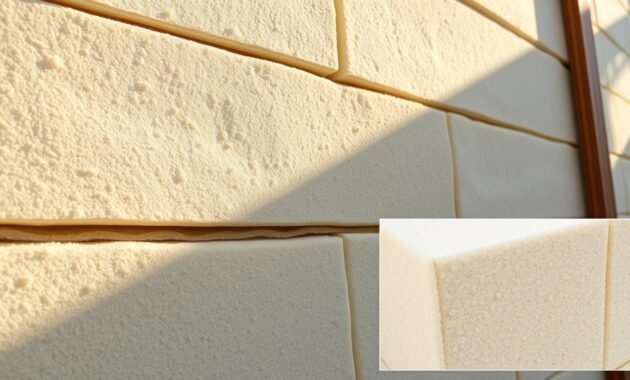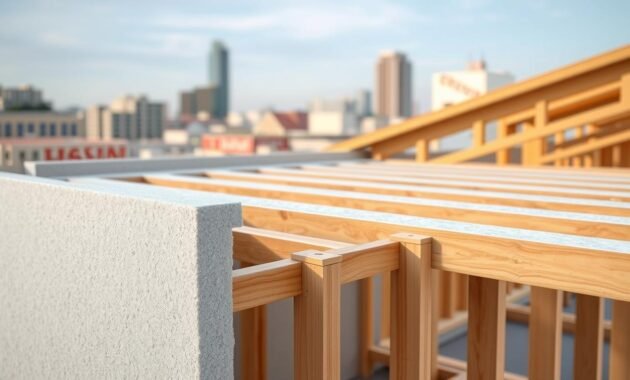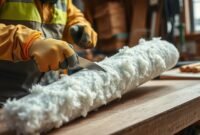Are you fed up with high energy bills and uncomfortable home temperatures? Many people face issues with insulation that makes their homes too cold in winter and too hot in summer. Using rigid foam over batt insulation could be the answer you’ve been looking for.
Traditional insulation methods often don’t keep your home warm or cool enough. Adding rigid foam over batt insulation is a strong way to seal your home. This combination boosts your home’s energy efficiency and comfort.
In this article, I’ll explain why using rigid foam and batt insulation together is a smart choice for your home. You’ll learn about a detailed plan for better thermal performance.

Understanding Insulation Combinations for Better Home Efficiency
Choosing the right insulation is key to an energy-efficient home. It helps keep exterior walls warm in winter and cool in summer. Knowing about insulation materials and methods helps homeowners improve their home’s comfort.
Read also: R49 Batt Insulation
Types of Insulation Materials
There are many insulation materials to choose from. The most popular rigid foam insulations are:
- Expanded Polystyrene (EPS)
- Extruded Polystyrene (XPS)
- Polyisocyanurate (Polyiso)
Basic Principles of Heat Transfer
Heat transfer is important in insulation. Thermal bridging happens when heat moves through materials, wasting energy. Using flash and batt with rigid foam creates a solid barrier against heat, making walls more efficient.
R-Value Fundamentals
R-value shows how well insulation blocks heat. The higher the R-value, the better the insulation. Mixing insulation types like rigid foam and batt creates a strong thermal shield for your home.
Read also: Spray Foam vs Batt Insulation Pros and Cons
| Insulation Type | Average R-Value per Inch | Best Used For |
|---|---|---|
| EPS Foam | 3.6 – 4.0 | Exterior wall applications |
| XPS Foam | 4.5 – 5.0 | Below-grade insulation |
| Polyiso Foam | 5.5 – 6.0 | High-performance walls |
The Science Behind Rigid Foam Over Batt Insulation
Knowing the science behind insulation is key when choosing between rigid foam and fiberglass. Rigid foam and batt insulation together form a strong thermal shield. This shield helps tackle many energy issues in homes.
Rigid foam has special benefits that work well with fiberglass batts. Adding rigid foam to fiberglass boosts a home’s thermal performance. The science behind this involves three main points:
- Thermal resistance and R-value enhancement
- Air barrier capabilities
- Moisture management properties
The biggest scientific win is reducing thermal bridging. Rigid foam makes a solid insulation layer. This layer cuts down heat loss through walls and floors, making homes warmer and more energy-efficient.
Different rigid foam types, like polyisocyanurate and polystyrene, offer unique benefits. They vary in thermal resistance and moisture protection. This lets homeowners pick the best insulation for their climate.
Grasping the science of insulation layers helps you choose better for your home’s energy and comfort.
Benefits of Layering Different Insulation Types
Using foam board with batts is a smart way to make your home more energy-efficient. This method combines different insulation types for better thermal protection. It’s more effective than using just one type of insulation.
When you think about insulating your home, it’s key to know the benefits of mixing materials. Rigid foam and batt insulation together make a stronger thermal barrier. This meets more needs than single-material solutions.
Enhanced Thermal Performance
Rigid foam sheathing is very good at insulation, with R-values from 3.6 to 8.0 per inch. By adding foam board with batts, you get:
- A higher overall R-value
- Better temperature control
- Less heat transfer
Moisture Control Advantages
Layering insulation types also helps control moisture better. This mix creates a strong barrier against water and moisture.
Read also: Should I Insulate Interior Walls?
| Insulation Type | Moisture Resistance | Thermal Performance |
|---|---|---|
| Rigid Foam | Excellent | High (R-4 to R-8 per inch) |
| Fiberglass Batts | Limited | Moderate (R-2.2 to R-4 per inch) |
| Combined Approach | Superior | Maximized |
Cost-Effectiveness Analysis
Though it might cost more upfront, using foam board with batts can save a lot of money in the long run. You’ll spend less on heating and cooling.
- Lower energy bills
- More comfort at home
- Longer protection for your building
Preventing Thermal Bridging with Exterior Rigid Foam

Thermal bridging is a big problem for home energy efficiency. Rigid foam exterior insulation is a strong solution. It stops heat from escaping through building parts.
I’ve seen how rigid foam boosts a home’s warmth. It makes a solid insulation layer. This layer stops heat from escaping.
There are key spots where stopping thermal bridging is essential:
- Wall studs and framing connections
- Window and door frame intersections
- Roof and wall junctions
- Foundation and wall transitions
Different materials conduct heat in different ways. Wood and metal studs can let a lot of heat escape.
| Material | Thermal Conductivity | Bridging Impact |
|---|---|---|
| Wood Studs | High | Significant Heat Loss |
| Steel Framing | Very High | Extreme Heat Transfer |
| Rigid Foam Insulation | Low | Minimal Heat Transfer |
Using rigid foam insulation helps keep homes warm. It saves energy and makes homes more comfortable.
Rigid Foam Over Batt Insulation: Installation Guidelines
Installing rigid foam over batt insulation needs careful planning and precision. The insulation sandwich technique boosts your home’s thermal performance if done right. I’ll guide you through the essential steps for a successful installation.
Surface Preparation Requirements
Proper surface preparation is key for a successful insulation project. Here are the main steps I recommend:
- Clean the installation surface thoroughly, removing dust and debris
- Check for any structural damage or moisture issues
- Ensure the surface is completely dry and smooth
- Repair any gaps or cracks before beginning installation
Proper Sealing Techniques
Effective sealing is vital to prevent air leakage and enhance insulation performance. I suggest the following sealing methods:
- Use manufacturer-recommended tape for foam board seams
- Apply foam-compatible sealant around edges and penetrations
- Create a continuous air barrier by carefully overlapping foam panels
- Inspect all seams and connections for any gaps
Common Installation Mistakes to Avoid
Even experienced DIY enthusiasts can make critical errors during insulation installation. Watch out for these common pitfalls:
- Leaving gaps between foam panels
- Using incompatible sealing materials
- Failing to account for proper ventilation
- Neglecting moisture barrier requirements
By following these guidelines, you’ll create an effective insulation system. This system maximizes energy efficiency and protects your home from thermal bridging. Remember, precision is key when implementing the insulation sandwich technique.
Comparing R-Values: Combined vs. Single Material Approach
When designing a hybrid insulation system, knowing the r-value of foam and batt is key. It helps make homes more energy efficient. My research shows how different materials work together and perform.
Rigid foam and batt insulation make a strong thermal barrier when layered right. For example, Rmax rigid foam has about 6 r-value per inch. This means around 21 r-value in a standard 2×4 stud bay. Adding rockwool to rigid foam boosts the insulation even more.
- Rigid foam provides excellent air sealing properties
- Rockwool offers superior sound dampening
- Combined approach reduces thermal bridging
Now, let’s look at the possible r-value setups:
| Insulation Type | R-Value per Inch | Total R-Value |
|---|---|---|
| Rigid Foam Only | 6.0 | 21.0 |
| Rigid Foam + Rockwool | 4.2 | 14.0 |
Climate zones and wall thickness affect insulation performance. Homeowners should talk to local energy experts. They can help find the best hybrid insulation system for their homes.
Moisture Management and Vapor Control
When you put foam board over existing insulation, knowing about moisture is key. It keeps your home healthy and safe from damage. This is important for your home’s long-term health.
Rigid foam helps stop thermal bridging by making a solid insulation layer. This layer lowers the chance of moisture problems. It keeps your home’s structure strong by controlling moisture.
Dew Point Considerations
Knowing about dew point is vital when using foam board. Dew point is the temperature where water vapor turns into liquid. This can cause moisture issues.
- Identify where moisture might condense in walls
- Figure out temperature differences in insulation
- Choose the right vapor barrier materials
Ventilation Requirements
Good ventilation is key for preventing thermal bridging. It helps keep moisture levels down and stops mold from growing.
| Insulation Type | Moisture Risk | Recommended Ventilation |
|---|---|---|
| Rigid Foam + Batt | Low to Moderate | Balanced Mechanical Ventilation |
| Single Layer Insulation | High | Continuous Air Exchange |
By managing moisture and using smart ventilation, homeowners can make their insulation work better. This protects their property from moisture damage.
Building Code Compliance and Requirements

Understanding building code rules for exterior walls and insulation can be tough. As a homeowner or contractor, knowing these rules is key. It ensures your insulation project is legal and works well.
ENERGY STAR™ sets specific insulation rules for different areas. These rules change based on where you live and the type of building. Here are the main things to keep in mind:
- Climate Zones 1-4 need at least R-3 insulation
- Climate Zones 5-8 require R-5 insulation
- Metal-framed walls must have rigid foam or insulated siding
When you install rigid foam insulation, there are important things to think about. Local codes might ask for more than ENERGY STAR™ suggests. You’ll need to look at things like how to install it, the vapor barrier, and fire safety.
It’s smart to talk to a professional contractor about this. They can help you make sure you follow all the rules. Each area has its own rules that can affect your insulation plan. You’ll need to document everything and get it checked to avoid fines.
Read also: How to Insulate Single Pane Windows?
Here are the main things to remember for code compliance:
- Check the local building code rules
- Get the right permits
- Use the correct installation methods
- Meet the thermal performance standards
By following these steps, you can make a home that saves energy and meets all the building codes.
Cost Analysis and Long-Term Energy Savings
Getting a hybrid insulation system with flash and batt with rigid foam might cost a lot at first. But, the long-term savings are much greater than the initial cost.
When thinking about upgrading your home’s insulation, look at a few important financial points:
- Initial material and installation costs
- Potential energy bill reductions
- Long-term performance of the hybrid insulation system
- Expected return on investment timeframe
Initial Investment Breakdown
A typical rigid foam over batt insulation project costs between $1.50 and $3.00 per square foot. It might seem expensive, but the energy savings are huge. Homeowners can save their money back in 5-7 years through lower heating and cooling bills.
Return on Investment Calculations
Using a hybrid insulation system can save 20-30% on energy each year. It creates a solid insulation barrier, cutting down on heat loss and improving your home’s energy use.
Energy Bill Impact
Studies show homes with flash and batt with rigid foam save $300-$500 a year on energy bills. These savings make the initial cost worth it for those looking to save money in the long run.
Conclusion
Exploring rigid foam over batt insulation has shown me it’s more than a trend. It’s a smart way to improve your home. When you mix rigid foam with batt insulation, your home’s energy use can really drop.
Every home is different, and insulation needs vary. Rigid foam over batt insulation boosts energy efficiency and controls moisture. But, it’s not for every home.
Before choosing, think about your climate, home type, and budget. Energy auditors can help figure out if this method is right for you. The goal is to make your home comfortable and energy-efficient.
Doing your homework and talking to experts is key. The right insulation choice can make your home more comfortable and save you money.


